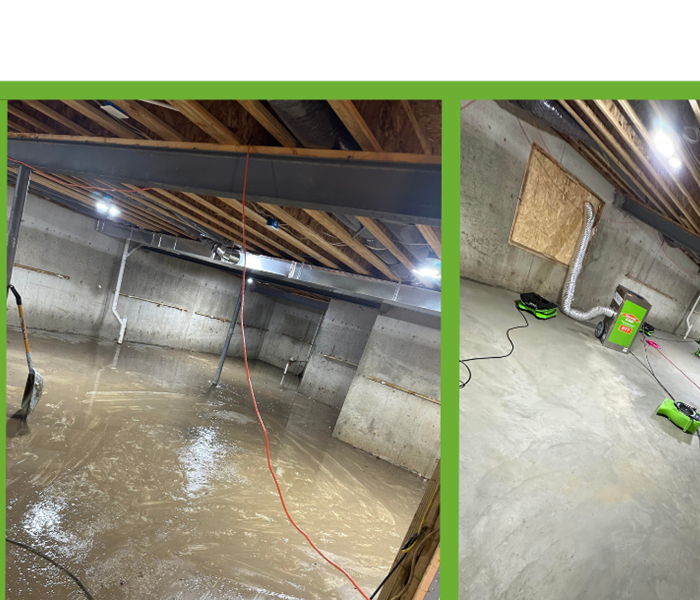Recent Posts
Grease Fire and The Holidays
12/18/2023 (Permalink)
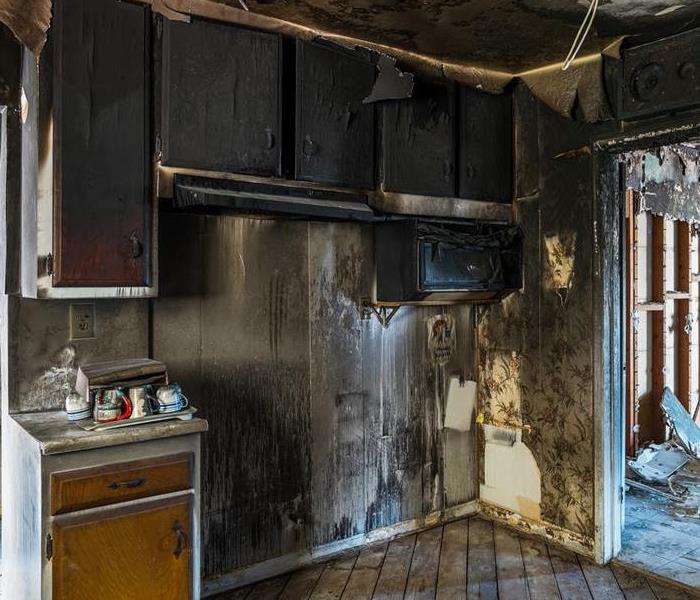 A fire damaged kitchen
A fire damaged kitchen
These are important safety tips for anyone cooking with hot oil, especially during the holiday season when deep frying is common. Here's a summary of those tips for a safe and enjoyable cooking experience:
When Cooking with Hot Oil:
Stay in the Kitchen: Never leave the stove or deep fryer unattended while it's in use. Most grease fires occur when people step away from the kitchen.
Heat the Oil Gradually: Slowly heat the oil to the desired temperature to avoid overheating, which can lead to fires.
Monitor the Temperature: If you suspect the oil is getting too hot, turn off the burner to prevent it from igniting.
Careful Placement: Gently place food into the hot grease to prevent splattering and burns.
Fire Safety: If a grease fire starts, immediately use a fire-smothering method. Options include using a pan lid, cookie sheet, cat litter, a fire extinguisher, flour, or a wet cloth to extinguish the flames.
Avoid These Actions:
Don't Carry the Pan Outside: Moving a burning pan outside can be dangerous and may cause severe injuries. It's best to handle the fire right where it started.
Avoid Panicking: Panicking can lead to poor decisions, like splashing the grease or knocking over the pan. Stay calm and act quickly but with caution.
Don't Use Water or Dry Cloths: Water should never be used to extinguish a grease fire, as it can cause the fire to spread. Dry cloths are also not effective. Use the recommended fire-smothering methods mentioned earlier.
Special Consideration for Turkey Fryers:
When using turkey fryers, it's essential to follow specific safety precautions:
Outdoor Use: Always use turkey fryers outdoors, away from any structures or flammable materials. This reduces the risk of a fire spreading to your home.
Maintain Safe Distances: Ensure the fryer is placed on a stable, level surface and at a safe distance from any walls or structures.
Thaw the Turkey: Make sure the turkey is fully thawed and dried before lowering it into the hot oil. Ice or water on the bird can cause violent reactions when submerged in hot oil.
Use Appropriate Safety Gear: Wear appropriate safety gear, like oven mitts and safety goggles, when operating a turkey fryer.
By following these guidelines, you can reduce the risk of accidents and enjoy a safe and delicious holiday cooking experience. Remember to prioritize safety and be prepared for emergencies by keeping a fire extinguisher on hand. If a fire does occur, Call 911, and then call SERVPRO®, we are hear to help.
Restoring and Repairing your home cost effectively
12/18/2023 (Permalink)
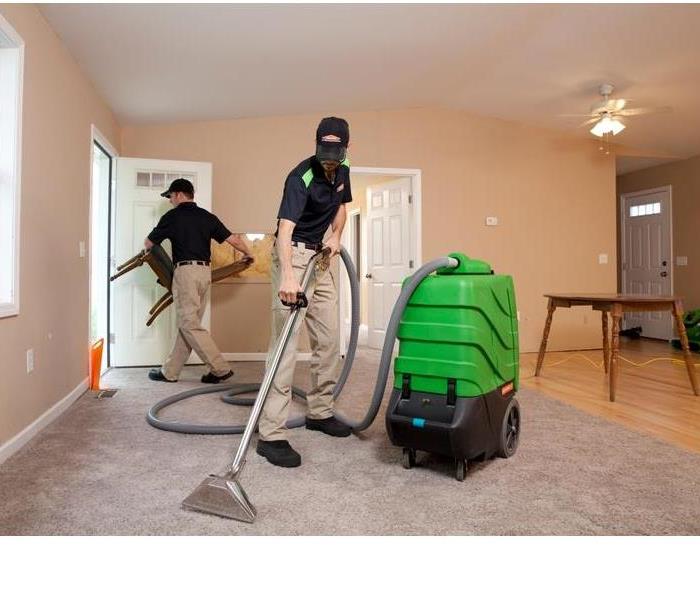 SERVPRO is here to help with all your Restoration and repair needs after a flood
SERVPRO is here to help with all your Restoration and repair needs after a flood
Restoring and repairing a home after flood damage requires a comprehensive approach to ensure efficiency and cost-effectiveness. Understanding the complete flood restoration process is crucial in engaging the right professionals for this daunting task. It encompasses various stages of repair and cleaning, all of which our team of qualified experts is equipped to handle. Recognizing the significance of professional assistance in returning homes and businesses to their preloss condition is paramount.
In addressing flood damage, prompt action is imperative, starting with containment and emergency services. These initial steps are crucial before mitigation or scoping of the job. Effective planning precedes the restoration process, but certain immediate actions cannot be delayed and need inclusion in the overall restoration plan. Our team employs efficient strategies, commencing with communication through our SERVPRO emergency line.
The gathering of information about the disaster is pivotal. Our professionals rely on data shared through our emergency line to prepare adequately. Thorough details enable us to mobilize the right personnel, equipment, and products from our warehouse. There are three primary ways we gather essential data for formulating a restoration plan:
- Emergency Phone Call: Sharing comprehensive information with our emergency line operators prepares our technicians for the situation awaiting them.
- Job Scoping: Our experienced project managers assess the flood-damaged property, determining necessary actions for restoration and documenting losses or additional measures needed.
- Customer Conversations: Leveraging the customer's insights helps prioritize actions during the restoration process.
Creating staging areas is an efficient approach our SERVPRO technicians utilize. These areas, set up in unaffected sections of the home close to the damaged areas, facilitate easy access to equipment and protective gear. This practice minimizes trips in and out of the house, ensuring efficiency, convenience, preventing cross-contamination, and proximity to drying/work zones.
Efficient strategies for water extraction are vital due to the potential damage caused by standing water. Removal of standing water is crucial to focus on drying, cleaning, and other recovery actions. Various methods are employed:
- Trash Pumps: These gas-powered pumps effectively remove flood water, including smaller solids and debris.
- Wet Vacuums: Versatile extractors with different attachments suitable for removing water below two inches in depth.
- Subcontractors: In cases of severe contamination, subcontractors may be engaged for handling blackwater incidents.
Numerous initial tasks must be addressed promptly after a flood, bridging the gap between potential contamination and removing bulk materials. Our dedicated team of water restoration technicians and cleaning specialists is committed to restoring the property to its original state seamlessly, ensuring it's "Like it never even happened."
HVAC cleaning this holiday season
12/18/2023 (Permalink)
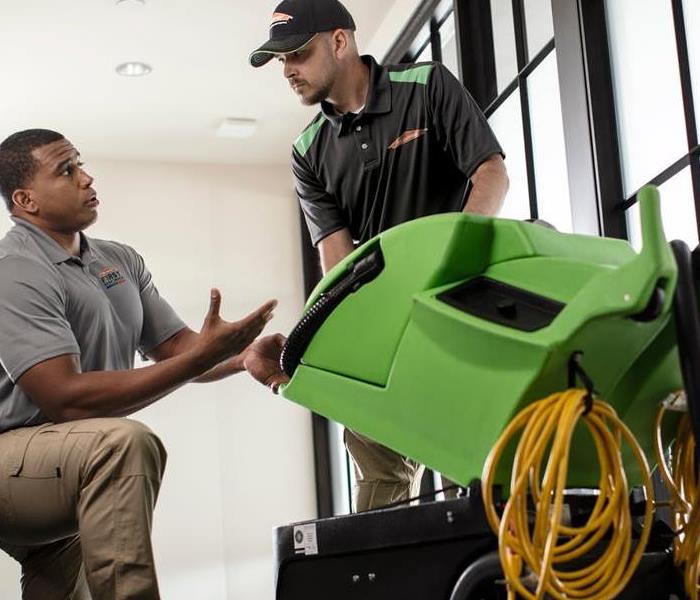 Get your HVAC cleaned just in time for the holidays!
Get your HVAC cleaned just in time for the holidays!
As the holiday season approaches and families prepare to gather indoors, ensuring a clean and healthy environment becomes paramount. One often overlooked aspect of maintaining indoor air quality is the regular cleaning of HVAC (Heating, Ventilation, and Air Conditioning) systems. At SERVPRO®, we recognize the significance of HVAC cleaning in preserving a safe and comfortable living space, especially during festive seasons. Let's delve into why HVAC cleaning is crucial and how our professional services can make a difference.
Health and Indoor Air Quality Improvement: HVAC systems circulate air throughout your home, influencing the quality of the air you breathe. Over time, dust, debris, pollen, and even mold can accumulate within these systems, contaminating the air supply. Regular cleaning by SERVPRO helps remove these pollutants, reducing respiratory issues, allergies, and potential health risks for your family.
Enhanced Energy Efficiency: A clean HVAC system operates more efficiently. Accumulated debris forces the system to work harder to maintain desired temperatures, leading to increased energy consumption and higher utility bills. SERVPRO's professional cleaning ensures that your HVAC system runs optimally, potentially lowering energy costs and increasing its lifespan.
Prevention of Mold and Moisture Build-Up: HVAC systems can become breeding grounds for mold and bacteria when moisture is present. Moisture buildup can occur due to various reasons like condensation or leaks. SERVPRO's thorough cleaning helps eliminate these potential havens for mold, preventing its growth and safeguarding your home against related health hazards.
Prolonging Equipment Life: Neglected HVAC systems are prone to wear and tear, leading to frequent breakdowns and expensive repairs. Regular maintenance and cleaning provided by SERVPRO can extend the life expectancy of your HVAC system, saving you from costly replacements down the line.
Professional Expertise and Comprehensive Service: SERVPRO technicians are trained and equipped to handle HVAC cleaning with precision and efficiency. Our comprehensive services cover ductwork, filters, coils, and other components, ensuring a thorough and meticulous cleaning process that leaves your system operating at its best.
As the holiday season beckons, prioritizing a healthy indoor environment is crucial for the well-being of your family and guests. HVAC cleaning stands as an essential step in achieving this goal, and SERVPRO is dedicated to helping you maintain a clean, safe, and comfortable home. Trust our expertise and commitment to quality service to keep your HVAC system running efficiently, promoting healthier indoor air quality for a joyful and worry-free holiday season.
Contact SERVPRO today to schedule your HVAC cleaning and ensure a refreshing indoor environment for your celebrations!
Revitalize Your Workspace with Professional Carpet Cleaning Services by SERVPRO
11/2/2023 (Permalink)
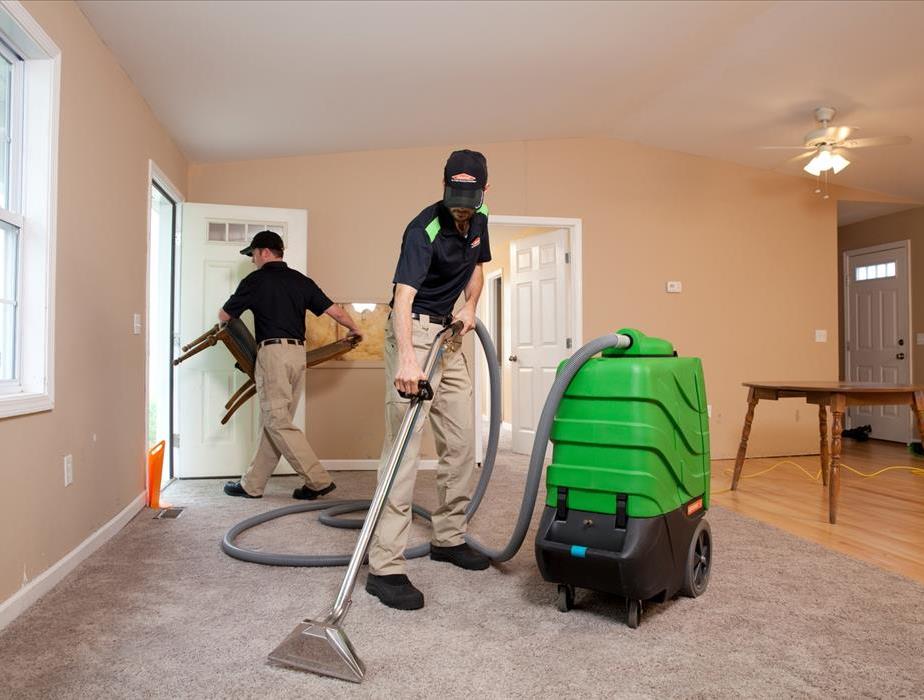 Carpet Cleaning
Carpet Cleaning
In the fast-paced world of commercial business, maintaining a clean and inviting workspace is crucial. Among the many facets of office maintenance, carpet cleanliness often takes center stage. A clean carpet not only enhances the aesthetics of your office but also contributes to a healthier and more productive work environment. That's where SERVPRO, a trusted name in the restoration and cleaning industry, can make a significant difference.
Why Carpet Cleaning Matters
Carpeting is a common choice for commercial spaces due to its durability and sound-absorbing properties. However, it's also a magnet for dirt, dust, allergens, and stains. Over time, neglected carpets can accumulate these contaminants, resulting in reduced air quality, unpleasant odors, and a negative first impression for clients and employees. This is where professional carpet cleaning becomes essential.
SERVPRO: Your Trusted Partner
SERVPRO, with its decades of experience in cleaning and restoration, offers comprehensive commercial carpet cleaning services that can transform your workspace. Here's why SERVPRO stands out:
1. Cutting-Edge Equipment and Techniques: SERVPRO uses state-of-the-art equipment and industry-best practices for carpet cleaning. Their highly trained technicians are well-versed in the latest techniques to provide the most effective solutions.
2. Customized Cleaning Plans: Every commercial space is unique. SERVPRO tailors their services to meet your specific needs. Whether you have high-traffic areas, stubborn stains, or just need regular maintenance, they can create a plan that suits your business.
3. Healtheir Work Environment: Clean carpets mean healthier air quality. SERVPRO's deep cleaning removes allergens and pollutants, contributing to a healthier workspace and potentially reducing employee sick days.
4. Enhanced Aesthetics: Clean carpets create a professional and welcoming atmosphere for your clients and employees. A tidy workplace can boost employee morale and leave a lasting positive impression on visitors.
5. Prolonged Carpet Lifespan: Regular professional cleaning not only keeps your carpets looking great but also extends their lifespan. This can save your business money in the long run.
6. Emergency Services: In the event of unexpected accidents, such as water damage or flooding, SERVPRO offers emergency carpet cleaning and restoration services to minimize downtime and protect your assets.
The SERVPRO Process
When you choose SERVPRO for your commercial carpet cleaning needs, you can expect a meticulous and thorough process:
1. Inspection: Technicians begin by inspecting your carpets to assess their condition, identify stains, and determine the best cleaning method.
2. Pre-Treatment: They pre-treat stains and high-traffic areas to ensure effective removal of dirt and grime.
3. Cleaning: Using their advanced equipment, SERVPRO technicians perform a deep cleaning, removing embedded dirt, allergens, and stains.
4. Drying: After cleaning, they ensure your carpets are properly dried, preventing mold and mildew growth.
5. Post-Cleaning Inspection: A final inspection guarantees that your carpets meet SERVPRO's high standards for cleanliness and appearance.
Experience the SERVPRO Difference
In the world of commercial carpet cleaning, SERVPRO is a name synonymous with excellence. Their commitment to quality, attention to detail, and industry-leading techniques can help you maintain a clean, inviting, and healthy workspace. With SERVPRO by your side, you can confidently focus on what matters most – your business success – while they take care of the cleanliness and aesthetics of your office.
Don't let dirty carpets hold back your business's potential. Contact SERVPRO today and discover how their professional carpet cleaning services can transform your commercial space.
Michigan 2023: fast flooding requires fast action.
9/25/2023 (Permalink)
the recent flash flooding that occurred in Michigan left a lot of local resident in peril. In news reports they say some businesses were left as "Islands," and homes were virtually underwater. With all of the local company's overloaded with calls, we send our team of water mitigation specialists to help. After 3 weeks of working day and night our team helped many people get their homes cleaned up and ready for reconstruction. Some of the work done, included sewage backups in their basements, main floor flooding, or water coming in from the outside.
After leaving their families, driving across the country (South Carolina to Michigan) and then immediately getting to work to exact and dry, Our team has returned safely home.
Pets Starting Fires During the Holidays in Oconee County
12/15/2022 (Permalink)
 We respond to fire damage emergencies 24-hours a day in Oconee and South Anderson Counties.
We respond to fire damage emergencies 24-hours a day in Oconee and South Anderson Counties.
The winter season is a busy time for all, our pets included! According to the American Red Cross, more home fires occur during December and January each year on Saturdays and Sundays. Our pets are curious creatures responsible for starting approximately 750 fires each year in the United States. Here are some fire safety tips for pets from the National Fire Protection Association:
- Some pets are chewers. Watch pets to make sure they don’t chew through electrical cords. Have any problems checked by a professional.
- Keep pets away from stoves and countertops
- Keep pets away from candles, lamps, and space heaters
- Always use a metal or heat-tempered glass screen on a fireplace and keep it in place
- Keep pets away from a chimney’s outside vents.
- Have a “pet-free zone” of at least three feet away from the fireplace. Glass doors and screens can stay dangerously hot for several hours after the fire goes out.
Call Us Today!
When you have a fire damage emergency in your Oconee County home or business, you can rely on our team at SERVPRO of Oconee/South Anderson Counties to restore the damage “Like it never even happened.” Call us today at 864.916.4160.
Franchises are independently owned and operated.
HOW CLUTTER AFFECTS INDOOR AIR QUALITY
12/2/2022 (Permalink)
 Cluttered room
Cluttered room
The word clutter shows that it means no good. It generally refers to mess. It talks about the years and years of stuff that has been accumulated. With respect to air quality, clutter is poisonous. The more stuff you have, the more you are likely to pollute the air in the house. That is because you are providing more locations for clutter to feed and grow on.
Here’s the impact clutter can have on the quality of your air.
- Some Pollutants are Harder to Clean
Pollutants like from water damage can be detrimental to the health of your indoor air. They hide in moist areas where most families store things, areas like garage, kitchen and laundry room. They can lead to health problems and trigger allergens and asthma.
- Clutter is hard to clean after a while
Sometimes cleaning a room you’ve been meaning to clean for a while is hard to do. It’s because you don’t feel like cleaning, but after a while, letting clutter buildup makes it harder to get rid of. Clutter can lead to dust build up in forgettable areas like cluttered tabletops, shelving and dressers.
Dust is one of the leading causes of poor indoor air quality since your home’s HVAC system’s filter has to work harder to trap dust.
- Clutter leads to less air circulation
Poor air circulation is bas for your health, so making sure your home has good air circulation is important. When you take time to declutter those areas you’ve been putting off for w awhile, try opening a window as you clean. Fresh air is a great way to improve air circulation and indoor air quality.
If you are seeking for proper cleaning of your home, call SERVPRO of Pickens County. We understand the stress and worry. Our technicians are trained to use specialized cleaning and disposal techniques. Call us at 864.855.3993!
DISINFECT YOUR WORKSPACE AND KEEP IT GERM FREE
12/2/2022 (Permalink)
 Clean Desk
Clean Desk
The physical environment of the workplace has a significant effort on the way that we work. When our space is a mess, so are we.
Whether you worked in an office or in a cubicle, you probably worked to keep it clean and disinfected. When you’re concerned about keeping yourself safe from sickness-causing germs, you’re probably ready to bust out some serious chemicals to help you to help you clean and disinfect your cubicle, desk, office, or home office. Unfortunately, while disinfectants can be a powerful safeguard against bacteria and viruses, they can also contain some pretty scary chemicals that can have serious health effects on you and your co-workers. All cleaning products are not created equal and not all of them are disinfectants. Only products registered by the Environmental Protection Agency which have gone under specific testing to ensure their efficacy. Also, just because a disinfectant can be used to effectively kill germs and bacteria does not mean it’s safe to come into contact with your skin, eyes and lungs.
SERVPRO of Pickens offers disinfection services. We work to clean and sanitize office buildings and other commercial facilities. We train our cleaners to sanitize surfaces based on the recommendations from the Center for Disease Control (CDC). We follow their guidelines and use various methods and products to clean surfaces and limit the spread of bacteria and viruses.
The best results come when the right tools are used, and consumer cleaning products don’t always provide the desired outcome. Our team has access to industrial strength chemicals, as well as specialized equipment that’s much more effective than that found in stores. All the cleaning supplies we use are registered with the EPA, so they’re sure to be eco-friendly.
When searching for a disinfection service, be sure to choose a company that is flexible and follows guidelines that protect workers’ safety and health. Call us at 864.855.3993
5 Things You Need To Know About Water Damage Statistics
10/28/2022 (Permalink)
When a pipe bursts, a drain backs up, or a flood occurs in your home, it can be hard to see past the mess. A million questions will run through your mind.
What do I do now?
What’s going to happen?
Is my stuff ruined?
And the most important question of all: Will my homeowner’s insurance cover the damage?
There’s no doubt about it. Water damage is extremely stressful, and the more you know about it, the better you’ll be able to decide how to address it. Here are five things that every homeowner needs to know about water damage.
1. There are different insurance policies for flood damage and water damage.
You might think that water is water, whether it’s from flooding or a burst pipe, but flood damage is not covered under homeowner’s insurance. If you live in an area likely to experience flooding, you will probably already have a separate policy through the National Flood Insurance Policy (NFIP). When you report the claim to the insurance company, make sure to specify whether the claim is for water damage or for flood damage, so they can begin adjusting your claim correctly.
2. Not all water damage is covered by your insurance.
It is a good idea to look over your insurance policy and familiarize yourself with any exclusion to your water damage coverage. For instance, most policies cover sudden damage, like water damage from a really bad storm or from an overflowing washing machine. On the other hand, any water damage that happens because you didn’t maintain the property may be excluded, as well as gradual leaks that caused water damage over time.
3. Once water damage has happened, the clock is ticking before it gets worse.
When your property has been water damaged, you don’t have the luxury of waiting around for a convenient time to start the cleanup. Secondary damage from mold growth can present serious health risks associated with mold in the living environment.
Mold spores are everywhere, but they need moisture and a nutrient source to grow. And that is exactly what your wet carpet or drywall offers.
There is a 24 to 48 hour window from the time something gets wet until mold CAN begin to grow. After that time, mold will multiply rapidly. When mold growth is widespread, you may need the services of SERVPRO mold remediation service to safely treat and remove the mold.
To prevent mold growth, you will need to get your property completely dry again within that 48-hour window. To do this, you’ll need to contact a company that specializes in water damage restoration and emergency water extraction. They will have the professional water removal equipment and drying equipment to get the job done as quickly as possible. Many have 24-hour a day emergency hotlines, so you can start recovering your property almost immediately.
4. Your insurance company needs to know right away.
It’s a good idea to call your insurance company right away when you discover water damage. Your insurance agent can start the claims process immediately, as well as guide you through the first steps you will need to take to protect your property from more damage, like stopping the source of the water at the main water turnoff.
5. The pollution level of the water is important.
Water damage is categorized as one of three levels by how polluted the water source was that caused the damage.
Category 1: Water from a clean water source, like a fresh water line for a dishwasher. This water will not cause illness or any ill effects.
Category 2: Water that may cause illness through contact. It may have bacteria in it,
Even though water may start out as Category 1, that doesn’t mean it will stay that way. Any contamination that the water touches, such as dirty carpeting or soil from the ground, can change water damage Category to 2 or even Category 3. And since standing breeds bacteria, the longer the water is around, the worse the contamination of your property.
More contamination can mean that the restoration team will have to use more aggressive measures to clean your structure and property, and it might mean that soft furnishings, like your carpet and the carpet pad, may have to be discarded for your safety.
Water damage can be dangerous and expensive, so preventing water damage is an important part of home maintenance. But if you know the basics of what to do once it happens, you can prevent it from doing its worst.
Water Damage Statistics
Water damage covers a broad range of potential loss. Homeowners understand that wear and tear will occur in any circumstance; however, there are a variety of unforeseen events that may trigger water damage. Natural disasters are often given the most blame for water damage, and they should, considering that the majority of damages due to water stem from some sort of outside environmental factor.
Nevertheless, water damage may come in a variety of forms. Understanding the sources of this type of damage is important to not only potentially preventing an incident, but more importantly, to understand where you stand in the eyes of your insurance provider. Water damage in homes most typically comes from the following causes:
- Frozen pipes
- Leaking pipes
- Leaky roof
- Broken washing machine hose
- Plumbing problems
- Insulations issues
The water damage statistics below will highlight the widespread nature of this issue. While many people do not view this as a common occurrence, water damage accounts for a significant number of homeowners insurance claims. The following are some of the most interesting water damage statistics:
- Almost 40 percent of all homeowners have said that they have experienced loss from water damage
- About 93 percent of all water damage can be prevented
- Water damage is the second most frequently filed insurance claim in the United States
- 250 gallons of water is released a day due to a 1/8-inch crack in a pipe
- About 20 percent of all insurance claims related to water damage of some kind
- Billions of dollars in property losses are spent each year as a direct result of water damages
Those homeowners with an understanding of the prospective damages associated with water are much more likely to stop problems before they become major issues. Hopefully these water damage statistics were able to shed some light on the vast complications that may arise from water in the home. If you or your family has experienced water damage and are looking to file a claim, contact Arguello, Hope & Associates for more information.
To get started today, simply fill out a Free Case Review form on this page.
Water Damage Insurance Coverage
First and foremost, homeowners must maintain an understanding of exactly what is and is not covered under their current insurance policy. Without this knowledge, homeowners will be left in shock when disaster strikes and they must pay for these damages out of pocket. Besides purchasing a flood policy for protection, you may be able to add coverage to your existing policy. These additions may cover things such as the following:
- Mold remediation (varies on state)
- Backup of drains or sewers
- Plumbing water damage
- Air conditioning damages
- Water heater damage
Homeowners must be astute in recognizing water damage as early as possible. When a sudden storm, plumbing issue, or sewer backup occurs, knowing what will be covered will ease stress and make the entire repair process much more fluid. To find out more, contact our SERVPRO!
6 Facts About Commercial Water Damage
10/26/2022 (Permalink)
When it comes to water damage to a residential or commercial property, there is more than meets the eye.
Here are some water facts and figures as they pertain to the restoration industry:
1. Water is capable of dissolving a variety of different substances. In fact, water is known as the “universal solvent” because it dissolves more substances than any other liquid.
2. A sheet of drywall standing upright with its edge sitting in a ½” of water can wick water up to 6 inches in less than three hours.
3. Mold typically begins to grow in 24 to 48 hours in an untreated moist environment.
4. A good indication of a failing hot water heater is a puddle of water underneath it, indicating a slow leak, or rusted or corroded fittings on the top of the heater. If you don’t investigate the leak ASAP, you may quickly flood your home because water heaters are under a great deal of water pressure.
5. There are three categories of water contamination defined in the restoration industry:
- Category One – Water from a clean water source with no substantial risk of causing sickness or discomfort. Examples include water from a broken water supply pipe or an overflowing bath tub.
- Category Two – Water that has a significant degree of chemical, biological, and/or physical contamination. Examples include water from aquariums, dishwasher or clothes washer leaks, and water entering the structure from below grade. Discharged Category One water that sits untreated more for more than 24 hours becomes Category Two.
- Category Three – Water emanating from a grossly unsanitary source or carrying disease causing agents. Examples include discharges from sewer or septic systems/pipes and flood waters. Discharged Category One water that sits more for more than 48 hours becomes Category Three. Discharged Category Two water that sits more for more than 24 hours becomes Category Three.
6. Controlling pathogenic microorganisms during a restoration project may require the use of chemical agents that act as biocides. The United States Environmental Protection Agency (EPA) has defined three levels of biocidal activity:
- Sanitizers – Designed to reduce the number of microorganisms.
- Disinfectants – Designed to destroy or inhibit the growth of microorganisms but not necessarily their spores.
- Sterilizer – Designed to destroy all microorganisms (fungi/molds, bacteria, viruses, etc.) and their spores.





 24/7 Emergency Service
24/7 Emergency Service




